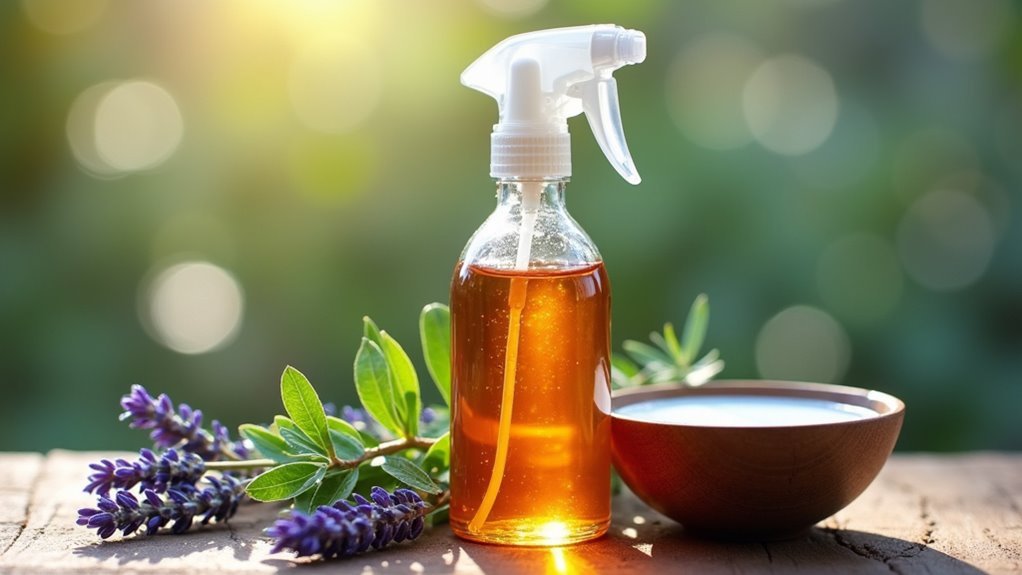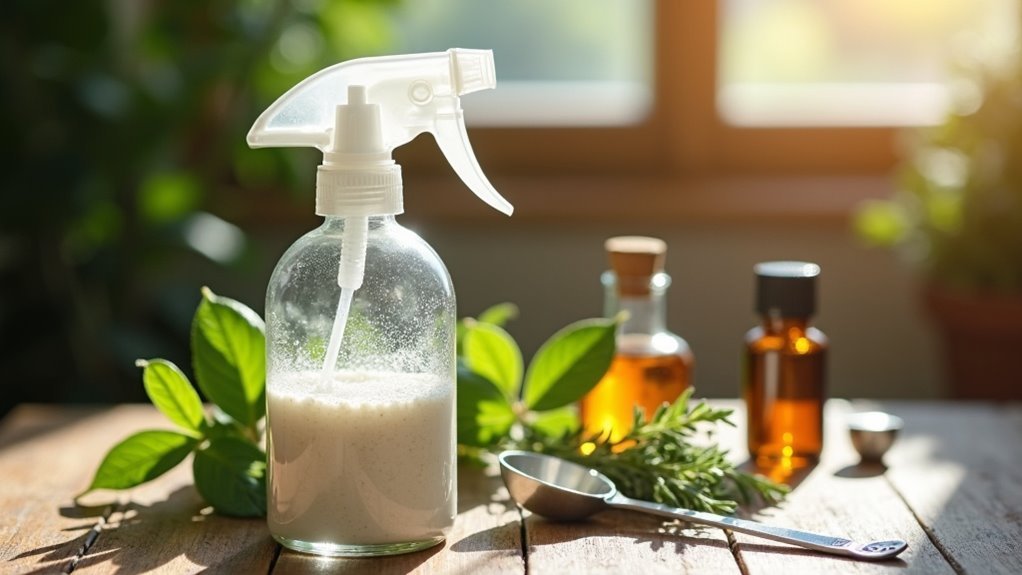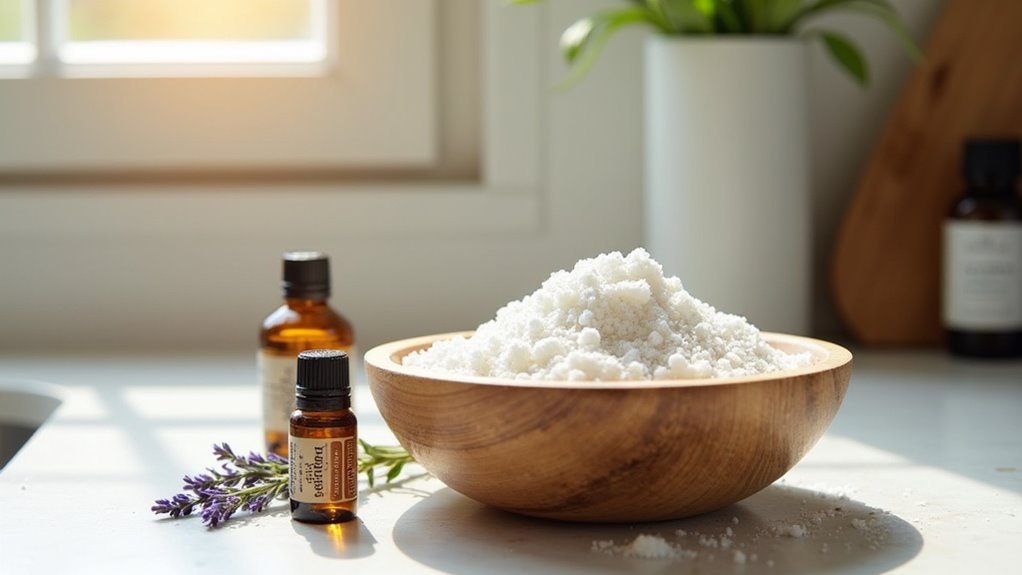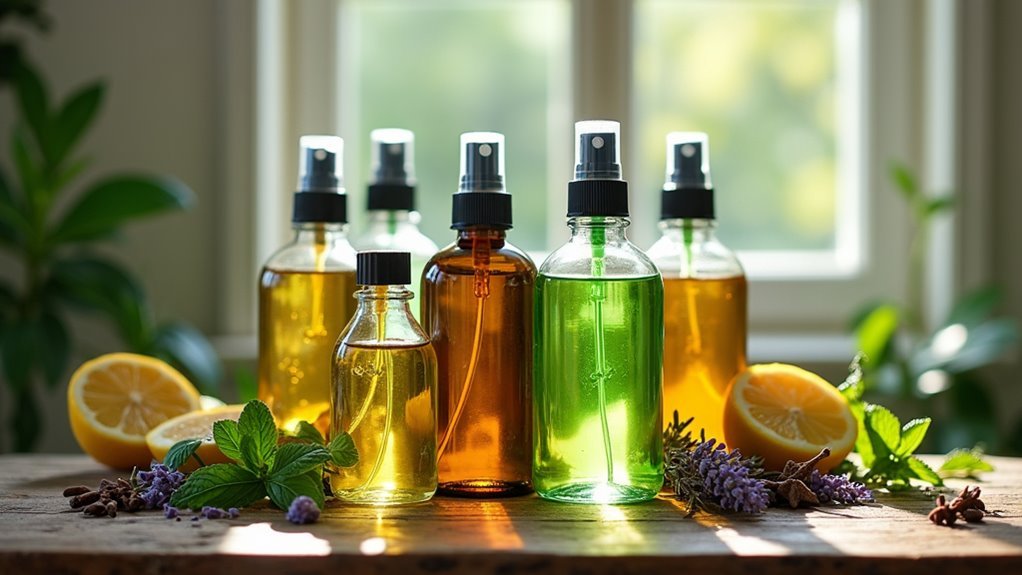You can create powerful homemade bed bug sprays using essential oils, vinegar, and household ingredients. Mix tea tree oil with water, combine white vinegar with dish soap, or blend multiple essential oils like peppermint, lavender, and oregano for maximum effectiveness. Diatomaceous earth spray mixtures dehydrate bugs mechanically, while baking soda combinations absorb moisture from their exoskeletons. These natural formulas kill on contact and repel future infestations when applied regularly to mattress seams, cracks, and hiding spots throughout your home’s treatment process.
Essential Oil and Vinegar Spray Recipe

When bed bugs invade your home, you can fight back with a powerful homemade spray that combines the insecticidal properties of vinegar with the repellent effects of essential oils.
This natural deterrent uses 8 drops of oregano essential oil, 4 drops of tea tree oil, 4 drops of lavender oil, 1 oz of vinegar, and 6 oz of filtered water in an 8 oz spray bottle.
The vinegar kills bed bugs on contact while repelling others with its strong odor. Essential oils provide antimicrobial properties and additional repellent effects.
Vinegar delivers immediate elimination upon contact while its pungent scent deters remaining bed bugs from returning to treated areas.
Mix all ingredients in a clean spray bottle, secure the lid, and shake well. Spray around corners, crevices, and hiding spots, repeating as needed.
Combine with regular hot-cycle bedding washes for maximum effectiveness.
Tea Tree Oil and Water Treatment Formula
For bed bug infestations that require a simpler yet effective approach, the Tea Tree Oil and Water Treatment Formula offers a powerful two-ingredient solution that harnesses tea tree oil’s anti-parasitic properties.
| Ingredient | Amount |
|---|---|
| Tea tree oil | 2 teaspoons |
| Water | 50 ml |
This natural insecticide doesn’t just kill bed bugs on contact—it also combats bacteria, viruses, and fungi for added health protection. You’ll want to spray this solution liberally in areas where bed bugs hide, focusing on cracks, crevices, and mattress seams. Regular application helps manage and reduce bed bug populations effectively. Combine this treatment with vacuuming and washing bedding for maximum results against these persistent pests.
Diatomaceous Earth Spray Mixture

You’ll find diatomaceous earth creates an effective, natural bed bug spray that works by dehydrating these pests through a unique mechanical action.
The mixing process requires specific ratios and techniques to guarantee the powder disperses properly in water for maximum coverage.
We’ll cover how this fossilized algae powder eliminates bed bugs, the exact recipe you need, and essential safety considerations for application.
How Diatomaceous Earth Works
Although diatomaceous earth isn’t typically used as a spray, you can create an effective liquid application by mixing this natural powder with water to target bed bugs in hard-to-reach areas.
Diatomaceous earth works by absorbing the external oils and fats from bed bugs’ exoskeletons, causing fatal dehydration. When bugs crawl through treated surfaces, the microscopic particles stick to their bodies and begin the deadly drying process.
| Application Method | Coverage Area | Effectiveness Duration |
|---|---|---|
| Thin powder layer | Beds, carpets, furniture | 2-3 weeks |
| Spray mixture | Cracks, crevices, baseboards | 1-2 weeks |
| Heavy dusting | Severe infestations | 3-4 weeks |
| Targeted application | Entry points, hiding spots | 1-3 weeks |
This chemical-free solution maintains over 90% mortality rates against bed bug infestations while remaining completely safe for your family and pets.
Mixing the Spray Recipe
Creating an effective diatomaceous earth spray requires precise measurements to confirm maximum bed bug elimination.
You’ll need to combine 1 cup of water with 1 tablespoon of food-grade diatomaceous earth for best results. Shake this homemade bed bug spray mixture thoroughly to make certain the powder disperses evenly throughout the water.
Use a fine mist spray bottle to apply the solution directly onto infested areas where bed bugs hide, including cracks, crevices, and bedding surfaces.
After spraying, allow the mixture to dry completely before vacuuming to maintain the diatomaceous earth’s dehydrating properties.
You’ll need to reapply this treatment every few days or after cleaning to sustain its effectiveness against persistent bed bug populations.
Application and Safety Tips
When applying diatomaceous earth spray mixture, target specific areas where bed bugs commonly hide, including bed frames, headboards, baseboards, and furniture cracks.
Focus your application on crevices and gaps where these pests shelter during daylight hours. Remember that powder form delivers better results than the diluted spray version for effective bed bug treatment.
Always use food-grade diatomaceous earth to guarantee safety for your family and pets during indoor application.
Leave the treatment undisturbed for at least one week, allowing the DE to dehydrate and eliminate bed bugs through moisture absorption.
After seven days, vacuum all treated areas to remove dead insects and debris.
Reapply fresh diatomaceous earth as needed to maintain ongoing pest control effectiveness.
Baking Soda and Essential Oil Combination

One of the most effective natural approaches combines baking soda’s moisture-absorbing properties with the insecticidal power of essential oils.
You’ll find that baking soda acts as a natural desiccant, absorbing moisture from bed bugs and effectively drying them out when applied consistently in infested areas. Essential oils like tea tree or lavender enhance this treatment’s effectiveness with their insecticidal properties that repel or kill these pests.
Create your mixture by combining two tablespoons of baking soda with a few drops of your chosen essential oil. Sprinkle this combination in areas where bed bugs typically hide.
Regular application disrupts their life cycles while preventing new infestations. This chemical-free method remains safe around pets and children, making it perfect for natural pest control.
Lemongrass Oil Bed Bug Repellent Spray
Lemongrass oil offers a powerful dual-action approach that both repels and kills bed bugs by increasing acidic conditions within their bodies.
You’ll find this natural solution more appealing than harsh chemical alternatives since it provides a pleasant scent while effectively targeting your bed bug infestation.
Create your spray by mixing 10-15 drops of lemongrass essential oil with 2 cups of water in a spray bottle.
Apply this solution liberally to mattress seams, cracks, and crevices where bed bugs typically hide.
The lemongrass oil disrupts their internal chemistry, leading to elimination while simultaneously deterring new bugs from entering treated areas.
Regular application keeps bed bugs at bay throughout your treatment process.
This cost-effective approach delivers results without exposing your family to toxic chemicals.
Oregano and Lavender Oil Power Blend
While oregano oil delivers lethal blows to adult bed bugs, lavender oil targets their eggs with precision, creating a thorough treatment that addresses all life stages of these persistent pests.
This dual-action essential oil approach eliminates bed bugs at every life stage for comprehensive pest control.
You’ll need 8 drops of oregano essential oil and 4 drops of lavender essential oil for this powerful combination.
Mix these with 1 oz of vinegar and 6 oz of filtered water in an 8 oz spray bottle. The vinegar amplifies effectiveness by dehydrating bed bugs on contact while repelling them with its pungent odor.
Focus your application on corners, crevices, and potential hiding spots where these insects gather. Reapply as needed for continuous protection.
Combined with regular cleaning and washing bedding, this essential oil blend helps maintain a bed bug-free environment through consistent use.
Peppermint and Citronella Dual-Action Spray
Combining peppermint and citronella oils creates a powerful dual-action spray that repels bed bugs while filling your home with a revitalizing scent.
You’ll need 10-15 drops each of peppermint oil and citronella oil mixed with 2 cups of water in a spray bottle. This potent combination targets bed bugs at various life stages while the invigorating peppermint aroma enhances your living space.
Apply the spray liberally to mattress seams, furniture cracks, and dark corners where bed bugs typically hide. The citronella provides additional protection against mosquitoes and other pests.
You’ll appreciate that both oils offer natural, eco-friendly alternatives to harsh chemical insecticides, making them perfect for households prioritizing safe pest control.
Reapply as needed to maintain continuous effectiveness against infestations.
White Vinegar and Dish Soap Formula
Another highly effective homemade solution harnesses the acidic power of white vinegar paired with dish soap to create a lethal combination against bed bugs.
The high acidity in white vinegar kills bed bugs on contact, while dish soap breaks down their protective layer, greatly enhancing treatment effectiveness.
You’ll need 1/8 cup of white vinegar, 2 teaspoons of dish soap, and 2 cups of water mixed in a spray bottle.
Apply directly to infested areas, targeting cracks, crevices, and seams where bed bugs hide. Repeat treatments every few days for ongoing protection.
Before widespread use, conduct a patch test on fabrics to prevent potential staining or damage.
This simple formula offers an accessible, powerful weapon against persistent infestations.
Multi-Essential Oil Protection Spray
For maximum protection against bed bug infestations, you can create a powerful multi-essential oil spray that harnesses the combined strength of tea tree, lavender, peppermint, and oregano oils.
These oils possess antimicrobial and antifungal properties that effectively repel and kill bed bugs on contact.
Mix 10-15 drops of your chosen essential oils with 2 cups of water and 1/8 cup of vinegar in a spray bottle.
Add dish soap to break down the bugs’ protective exoskeleton, enhancing the multi-essential oil protection spray’s effectiveness.
Apply liberally to cracks, crevices, seams, and hiding spots where bed bugs congregate.
This targets both adults and eggs.
Reapply regularly alongside other pest control measures like vacuuming and washing bedding to remove bed bugs completely from your home.
Alcohol-Free Natural Bed Bug Deterrent
You can create powerful bed bug deterrents without alcohol by combining specific essential oils that naturally repel and eliminate these pests.
Vinegar-based spray formulas offer excellent dual-action protection, killing bugs on contact while preventing future infestations through their high acidity levels.
Plant extract solutions provide another effective approach, harnessing nature’s insecticidal properties to maintain a bed bug-free environment safely.
Essential Oil Combinations
While commercial bed bug sprays often contain harsh chemicals, essential oil combinations offer a gentler yet effective alternative that won’t introduce toxic substances into your sleeping environment.
You can create powerful bed bug spray using tea tree, lavender, and peppermint oils, which possess antifungal and antimicrobial properties that repel and kill bed bugs on contact.
Mix 10-15 drops of your chosen essential oil combinations with 2 cups water, 2 teaspoons dish soap, and 1/8 cup vinegar.
The dish soap breaks down bed bugs’ protective outer layer, making them vulnerable to the oils and vinegar. This dual-purpose solution provides pleasant fragrance while controlling pests.
Regular application considerably reduces bed bug populations when combined with proper cleaning and monitoring practices.
Vinegar-Based Spray Formula
Another potent natural alternative relies on white vinegar’s powerful acidic properties to combat bed bug infestations without introducing alcohol into your home environment. This vinegar-based spray formula creates an effective deterrent that’s safe for most fabrics and surfaces.
| Ingredient | Amount |
|---|---|
| White vinegar | ½ cup |
| Water | ½ cup |
| Application frequency | Every few days |
You’ll combine equal parts white vinegar and water in a spray bottle for immediate use. The high acidity kills bed bugs on contact while the strong scent continues to repel bed bugs from treated areas. Apply this solution regularly to disrupt their lifecycle and prevent reinfestation. Remember, vinegar works best when combined with other pest control methods for thorough treatment.
Plant Extract Solutions
When you’re seeking powerful natural alternatives that eliminate harsh chemicals entirely, plant extracts offer some of the most effective bed bug deterrents available.
Tea tree oil stands out as a dual-purpose solution, repelling bed bugs while eliminating their eggs through its antibacterial and antifungal properties.
Lavender oil combines pest control with aromatherapy benefits, creating a calming bedroom atmosphere while deterring bugs with its strong scent.
Peppermint oil kills bed bugs on contact and provides excellent repelling properties.
Mix these plant extracts with water and vinegar to create potent homemade sprays.
Apply directly to cracks, crevices, and hiding spots where bed bugs congregate.
This alcohol-free approach delivers safe, natural pest control without compromising effectiveness against infestations.
Frequently Asked Questions
What Is the Best Homemade Bed Bug Killer?
You’ll find the best homemade bed bug killer combines 2 cups water, 10-15 drops essential oil, 2 teaspoons dish soap, and 1/8 cup vinegar. This mixture effectively kills bugs on contact.
What Chemical Kills Bed Bugs Permanently Naturally?
You’ll find diatomaceous earth kills bed bugs permanently through natural dehydration. Tea tree oil’s anti-parasitic properties also provide lethal effects. Both substances attack bed bugs’ moisture, causing death without synthetic chemicals or pesticides.
What Repels Bed Bugs From Biting You?
You can repel bed bugs by using essential oils like tea tree or lavender, applying vinegar around your bed, sprinkling diatomaceous earth nearby, and maintaining clean bedding washed in hot water regularly.
How Do You Make Your Own Bed Bug Spray?
You’ll mix 2 cups water, 10-15 drops essential oils, 2 teaspoons dish soap, and 1/8 cup vinegar in a spray bottle. Shake vigorously before using and test on fabrics first.
In Summary
You’ve now got nine powerful homemade bed bug spray recipes at your disposal. Remember, consistency is key—you’ll need to apply these treatments regularly and thoroughly to see results. Don’t expect overnight miracles, but with persistence, these natural solutions can help control your bed bug problem. Always test sprays on a small area first, and consider combining multiple recipes for maximum effectiveness against these stubborn pests.





Leave a Reply